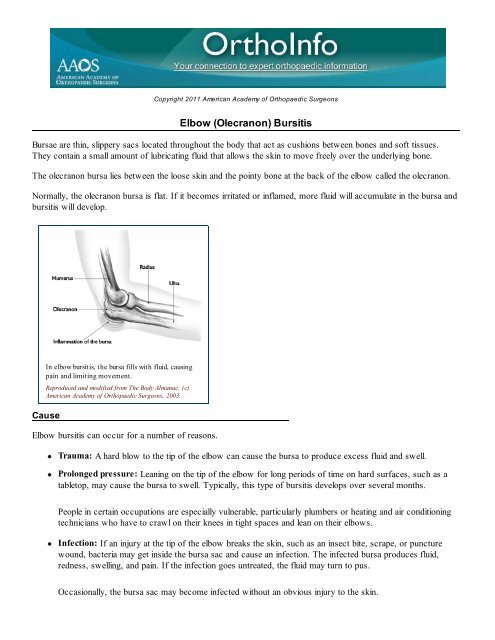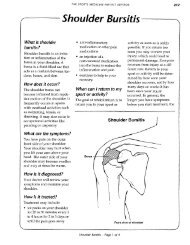Elbow (Olecranon) Bursitis - Your Orthopaedic Connection - AAOS
Elbow (Olecranon) Bursitis - Your Orthopaedic Connection - AAOS
Elbow (Olecranon) Bursitis - Your Orthopaedic Connection - AAOS
Create successful ePaper yourself
Turn your PDF publications into a flip-book with our unique Google optimized e-Paper software.
Copyright 2011 American Academy of <strong>Orthopaedic</strong> Surgeons<br />
<strong>Elbow</strong> (<strong>Olecranon</strong>) <strong>Bursitis</strong><br />
Bursae are thin, slippery sacs located throughout the body that act as cushions between bones and soft tissues.<br />
They contain a small amount of lubricating fluid that allows the skin to move freely over the underlying bone.<br />
The olecranon bursa lies between the loose skin and the pointy bone at the back of the elbow called the olecranon.<br />
Normally, the olecranon bursa is flat. If it becomes irritated or inflamed, more fluid will accumulate in the bursa and<br />
bursitis will develop.<br />
In elbow bursitis, the bursa fills with fluid, causing<br />
pain and limiting movement.<br />
Reproduced and modified from The Body Almanac. (c)<br />
American Academy of <strong>Orthopaedic</strong> Surgeons, 2003.<br />
Cause<br />
<strong>Elbow</strong> bursitis can occur for a number of reasons.<br />
Trauma: A hard blow to the tip of the elbow can cause the bursa to produce excess fluid and swell.<br />
Prolonged pressure: Leaning on the tip of the elbow for long periods of time on hard surfaces, such as a<br />
tabletop, may cause the bursa to swell. Typically, this type of bursitis develops over several months.<br />
People in certain occupations are especially vulnerable, particularly plumbers or heating and air conditioning<br />
technicians who have to crawl on their knees in tight spaces and lean on their elbows.<br />
Infection: If an injury at the tip of the elbow breaks the skin, such as an insect bite, scrape, or puncture<br />
wound, bacteria may get inside the bursa sac and cause an infection. The infected bursa produces fluid,<br />
redness, swelling, and pain. If the infection goes untreated, the fluid may turn to pus.<br />
Occasionally, the bursa sac may become infected without an obvious injury to the skin.
Symptoms<br />
Medical conditions: Certain conditions, such as rheumatoid arthritis and gout, are associated with elbow<br />
bursitis.<br />
Swelling is often the first symptom. The skin on the back of the elbow is loose, which means that a small amount of<br />
swelling may not be noticed right away.<br />
As the swelling continues, the bursa begins to stretch, which causes pain. The pain<br />
often worsens with direct pressure on the elbow or with bending the elbow. The<br />
swelling may grow large enough to restrict elbow motion.<br />
If the bursitis is infected, the skin becomes red and warm. If the infection is not<br />
treated right away, it may spread to other parts of the arm or move into the<br />
bloodstream. This can cause serious illness. Occasionally, an infected bursa will<br />
open spontaneously and drain pus.<br />
Doctor Examination and Tests<br />
After discussing your symptoms and medical history, your doctor will examine your<br />
arm and elbow.<br />
In many cases, the first sign<br />
of bursitis is swelling at the<br />
elbow.<br />
<strong>Your</strong> doctor may recommend an x-ray to look for a foreign body or a bone spur. Bone spurs are often found on the<br />
tip of the elbow bone in patients who have had repeated instances of elbow bursitis. <strong>Your</strong> doctor may choose to<br />
take a small sample of bursa fluid with a needle to diagnose whether the bursitis is caused by infection or gout.<br />
Blood tests are not usually helpful.<br />
Treatment<br />
Nonsurgical Treatment<br />
If your doctor suspects that bursitis is due to an infection, he or she may recommend aspirating (removing<br />
the fluid from) the bursa with a needle. This is commonly performed as an office procedure. Fluid removal<br />
helps relieve symptoms and gives your doctor a sample that can be looked at in a laboratory to identify if any<br />
bacteria are growing. This also lets your doctor know if a specific antibiotic is needed to fight the infection.<br />
<strong>Your</strong> doctor may prescribe antibiotics before the exact type of infection is identified. This is done to prevent<br />
the infection from progressing. The antibiotic that your doctor prescribes at this point will treat a number of<br />
possible infections.<br />
If the bursitis is not from an infection, it is treated with a number of options.<br />
<strong>Elbow</strong> pads. An elbow pad may be used to cushion your elbow.<br />
Activity changes. Avoid activities that cause direct pressure to your swollen elbow.<br />
Medications. Oral medications such as ibuprofen or other anti-inflammatories may be used to reduce<br />
swelling and relieve your symptoms.<br />
If swelling and pain do not respond to these measures after 3 to 4 weeks, your doctor may recommend<br />
removing fluid from the bursa and injecting a corticosteroid medication into the bursa. The steroid medication<br />
is an anti-inflammatory drug that is stronger than the medication that can be taken by mouth. Corticosteroid<br />
injections usually work well to relieve pain and swelling. However, symptoms can return.
<strong>Your</strong> doctor may remove fluid from the swollen<br />
bursa to check for infection, or to prepare the bursa<br />
for a corticosteroid injection.<br />
Reproduced with permission from JF Sarwark, ed:<br />
Essentials of Musculoskeletal Care, ed 4. Rosemont, IL,<br />
American Academy of <strong>Orthopaedic</strong> Surgeons, 2010.<br />
Surgical Treatment<br />
Surgery for infected bursa. If the bursa is infected and it does not improve with antibiotics or by removing<br />
fluid from the elbow, surgery to remove the entire bursa may be needed. This is often an inpatient procedure,<br />
meaning you will need to stay overnight in the hospital. This surgery may be combined with further use of<br />
oral or intravenous antibiotics.<br />
The bursa usually grows back as a non-inflamed, normally functioning bursa over a period of several<br />
months.<br />
Surgery for noninfected bursa. If elbow bursitis is not a result of infection, surgery may still be needed if<br />
nonsurgical treatments do not work. In this case, surgery to remove the bursa is usually performed as an<br />
outpatient procedure. The surgery does not disturb any muscle, ligament, or joint structures.<br />
Recovery. <strong>Your</strong> doctor will apply a splint to your arm after the procedure to protect your skin. In most<br />
cases, casts or prolonged immobilization are not necessary.<br />
Although formal physical therapy after surgery is not usually needed, your doctor will recommend specific<br />
exercises to improve your range of motion. These are typically permitted within a few days of the surgery.<br />
<strong>Your</strong> skin should be well healed within 10 to 14 days after the surgery, and after 3 to 4 weeks, your doctor<br />
may allow you to fully use your elbow. <strong>Your</strong> elbow may need to be padded or protected for several months<br />
to prevent reinjury.<br />
Last reviewed: January 2011<br />
<strong>AAOS</strong> does not endorse any treatments, procedures, products, or physicians referenced herein. This information is<br />
provided as an educational service and is not intended to serve as medical advice. Anyone seeking specific<br />
orthopaedic advice or assistance should consult his or her orthopaedic surgeon, or locate one in your area through<br />
the <strong>AAOS</strong> "Find an Orthopaedist" program on this website.<br />
Copyright 2011 American Academy of <strong>Orthopaedic</strong> Surgeons<br />
<strong>Your</strong> <strong>Orthopaedic</strong> <strong>Connection</strong><br />
The American Academy of <strong>Orthopaedic</strong> Surgeons<br />
6300 N. River Road<br />
Rosemont, IL 60018




